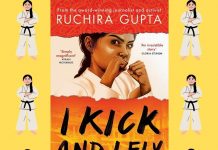What’s Wrong with You, Karthik?
by Siddhartha Vaidyanathan
Publisher: Picador India (2020)
Journeys to oft beaten paths almost always offer us that deja vu, that familiarity but as Helen Keller says, “Life is either a daring adventure or nothing”. In the current world of fiction writing, which largely dwells on issues and areas which are the concerns of adults, be it equality, gender, mental health, politics of the inner and outer worlds and so much more, Siddhartha Vaidyanathan in this debut novel, has chosen to explore the interior landscape of an adolescent’s mind and his view of the dynamic world around him. In doing so, offering his readers a delightful journey in 278 pages.
What’s Wrong with You, Karthik? is about a twelve year old boy who has just been granted admission to an old boys school in Bangalore. His parents, grandparents have filled his days and hours with carefully measured activity squares on the wall and typically his day is filled with a series of instruction boxes which need to be ticked efficiently. Yet, Karthik is not “polished enough, neat enough, not good enough”. The story spans across one year of Karthik’s life and the reader travels with him as he negotiates and meanders around this beast called life. Entering the hallowed portals of an elite school, Karthik is bombarded with unfamiliar and at times demeaning acts of bullying, feels ostracised and almost like those inflated “punch me” dolls. Simultaneously at home, a perennial struggle to live up to the perfect standards of Tatha , his grandfather and his father.
Karthik’s relationship with his Tatha is a rather heartwarming one. A strict, overtly religious, hard taskmaster on the surface, below which lurks an affectionate soul whose only aim is to make sure that his grandson excels in academics and maxes his Math paper. There’s a natural bonhomie when Tatha discusses cricket or when he bares his soul and reveals the importance of his typewriter in it. The rituals which Tatha shares with Karthik may weigh him down at times but the latter secretly looks forward to these. Moments with Tatha are either tender or tense. Lying on the hospital bed, Tatha’s curiosity to know Karthik’s Math marks or waking Karthik up at dawn to grill him on multiplication tables, the turmoil in the child’s mind is so palpable. Though a motley crew of characters are part of the story, the one which stays with us, besides Karthik, is an extremely well sketched Tatha.
Siddhartha Vaidyanathan seems to have a vivid and photographic memory of his schooldays and that gets reflected in the manner in which the ambience, the characters are presented in minute details. One has either studied in a such a school or had a brother/cousin/friend who went through similar experiences. This is why it makes the story that much more relatable. The quirks of the boys, teachers, staff have an universal appeal and this story could have been placed anywhere in India. Whistling risqué movie songs, signing names on pages, quirky names of boys, the slangs, the temptations add up to give an authentic picture of a boys school. On the other hand the other real issues of bullying, picking on the weaker kids, the cliques, the constant tussle to stay on the right track or make a wrong choice are all portrayed brilliantly.
Vaidyanathan is a master storyteller and while he uses a child’s voice, he strategically yet in a subtle manner, manages to raise a few questions aimed at parents, educators and adults per se.
– Why are marks the end-all and be-all?
– Why the constant pressure to perform and excel?
– Why will a child’s day be filled with ‘you-have-to-be-better-than-the-rest’ activities?
– Why are adults constantly looking for areas of improvement for kids?
– Why do adults ask mind numbing questions like” What do you want to be when you grow up?”
While the school, the boys and some of their personal lives come alive in the pages, the author has, in a quiet, restrained manner, touched upon some serious issues we adults need to introspect on. Through the twelve year old’s eyes, the reader actually gazes at the adult world and how a child, with all his innocence, observes and forms an opinion. Vaidyanathan has used Karthik’s eyes to shift the microscope on us . As Karthik watches the adults around him, some questions we end up asking ourselves.
– How do children interpret the internal politics within the family?
– How important are family rituals for kids?
– When will we stop saying, “What’s wrong with you ——–?”
Vaidyanathan has very deftly sprinkled the story with humour and some chuckles and guffaws are in store for the reader for sure. The 90s India comes alive with mentions of Competition Success Review, North Star Quiz Book and “the silly rainbow of sorrow”, the Doordarshan colour bar!
The novel ends with Karthik’s final term report card day but it is not a typical rose tinted happily ever after ending. He is now aware that there is no fixed formulae to win life’s struggles. He now knows that he has to make peace with fear, keep calm and he would find a way to brave the storms that come his way.
Like Robert Frost, Siddhartha Vaidyanathan took the path less travelled by and that has made all the difference.









Excellent review!!!!..It makes a reader instantly immerse into Karthik’s journey right after the first few lines with a smooth flowing buildup.. It helped me to resonate easily and made me to be inclined to get this debut novel ….Looking forward to more reviews from you Mohua…it helps to get a good headstart before choosing my reads…
Lovely review offering us a delightful peek into the machinations of a pre-teen mind – one which observes and absorbs the ever expanding world around it while trying to make sense of it all somehow.
At some point or the other in the growing up process , we’ve all been through that particular phase in life , placed in identical situations and faced with somewhat similar dilemmas .
Your review deftly reveals little , piquing the readers interest, urging him to venture forth , pick up the book and discover the entire canvas .
Last but not the least , the mention of the charismatic 90s immediately endears all who have lived through those times in their adolescence and youth .
It is a bond hard to break , harder to forget .
Brava !
Great review – clearly draws out the problems faced by helpless less exposed parents who project the same on their children, unaware of their repurcussions…